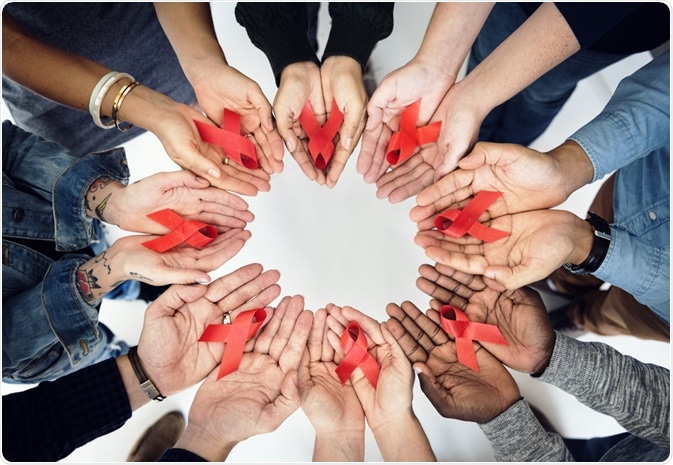AIDS is the final stage of a virus-driven by rapid genetic mutations, HIV. The epidemic, which started in the late 1970s to early 1980s, is widely believed to have begun when the virus crossed from chimpanzees (starting as a simian immunodeficiency virus that was non-pathogenic in its original host) to humans. Almost half a century of extensive research later and where do we stand in the fight against HIV?

Image Credit: Rawpixel.com/Shutterstock.com
Since the beginning of the AIDS epidemic, ~80 million people have become infected with HIV and over 35 million have lost their lives to AIDS-related illnesses. Over the last decade, mortality rates in females and males have fallen by 53% and 41%, respectively. Since the peak in 2004, AIDS-related deaths have reduced by 64%.
The incidence of new HIV infections has also fallen by 52%, since its peak in 1997. While these data may suggest that the fight against HIV is being won, there are still ~5,000 young women and girls infected with HIV every week. In sub-Saharan Africa, 4,200 young women and girls aged 15-24 are infected with HIV by every week. This accounted for 63% of all new HIV infections in 2020.
A reported 1.7 million children (aged 0-14 years) and 36 million adults were living with HIV globally in 2020; this accounted for an estimated 0.05% of the global population at the time. In 2020, 71% of those infected with HIV had access to antiretroviral therapies (ARTs); 22 million reported being unable to access treatment, and around 6.1 million of those living with HIV were unaware of their infection.
The genetic diversity of HIV has allowed it to evade the human immune system and develop resistance to many drugs. But, for the United Nations Programme on HIV/AIDS (UNAIDS) to achieve improvements, barriers resulting from economic status, gender, culture, politics, and society must also be overcome. Ending AIDS requires more than just medical advancements.
HIV fights back with gene mutations
The short, single-strand of the RNA genome in HIV is relatively unstable, accumulating mutations quickly. The reverse transcriptase enzyme, responsible for replicating the RNA genome, has no proofreading processes. This allows for errors/variations in the sequence to form frequently during RNA-dependent DNA synthesis. Once the strand of synthesized DNA has been inserted into the host cell’s chromosome, the host’s RNA polymerase is able to transcribe it.
Two classes of ARTs are commonly used to interfere with DNA synthesis: nucleoside and non-nucleoside reverse transcriptase inhibitors (NRTIs and NNRTIs, respectively). Most patients with HIV will be prescribed a combination of drugs (commonly two NRTIs and one NNRTI) for most if not all of their life. NRTIs are chain-terminating deoxynucleoside triphosphate (dNTPs) mimics, they lack the 3’-OH for incorporation of the next nucleotide during DNA synthesis. NNRTIs are allosteric inhibitors that induce conformational changes to reduce the “grip” of primers during DNA synthesis.
Due to the random integration of the HIV genome into the host chromosome, it can insert at any location and even interrupt genes. These non-specific therapies allow for those with genetic variations in HIV to still receive treatment. Nonetheless, the virus can develop resistance and, as with many treatment plans, patient non-adherence can exacerbate resistance.
Progression and expansion of HIV prevention
UNAIDS released an update in September of 2021, revealing the trend in uptake of therapy and reduced number of AIDS-related deaths as a result of their 2016-2020 strategy. The goals they set out in 2016 called for people living with HIV to be tested, start treatment, and reduce the HIV in their bodies to near undetectable levels.
By the end of 2020, 84% of those living with HIV knew their HIV status, 73% were accessing ARTs and 66% were virally suppressed. While this was shy of their 90-90-90 targets, UNAIDS speculates that “at least 40 countries are on track to achieve a 90% reduction in AIDS-related mortality by 2030, including nine countries in eastern and southern Africa.”
The Global HIV Prevention Coalition aims to assist populations in overcoming barriers to accessing healthcare. While the global trends in the number of new HIV diagnoses indicate a 23% reduction (in 2019, compared to 2010), three regions experienced substantial increases in the number of people with newly diagnosed HIV. Since its launch in 2017, the Coalition has helped 28 focus countries adopt national HIV prevention and leadership structures.
While the outcomes of these actions can’t be established yet, their fourth annual progress report of the HIV Prevention 2020 Road Map implementation highlights challenges and opportunities brought about by COVID, as well as the future priorities for HIV prevention.
Here they also discuss the “disappointing” results for coverage and outcomes of prevention programs for young women and girls in sub-Saharan Africa. As a key group who are considered vulnerable to HIV, the education of young women and girls in Sub-Saharan regions must be prioritized.
Further Reading
Last Updated: Nov 12, 2021